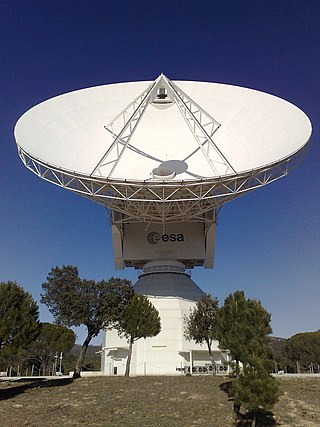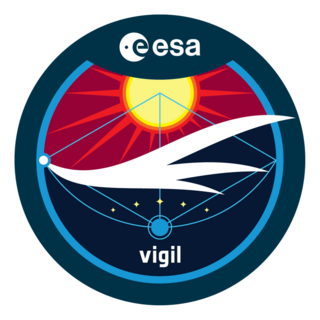
The European Space Operations Centre (ESOC) serves as the main mission control centre for the European Space Agency (ESA) and is located in Darmstadt, Germany. ESOC's primary function is the operation of uncrewed spacecraft on behalf of ESA and the launch and early orbit phases (LEOP) of ESA and third-party missions. The Centre is also responsible for a range of operations-related activities within ESA and in cooperation with ESA's industry and international partners, including ground systems engineering, software development, flight dynamics and navigation, development of mission control tools and techniques and space debris studies.

New Norcia Station is an ESTRACK Earth station in Australia for communication with spacecraft after launch, in low Earth orbit, in geostationary orbit and in deep space. It is located 10 kilometres (6.2 mi) south of the town of New Norcia, Western Australia. It was the first ESA deep space ground station, followed by Cebreros Station and Malargüe Station.

The European Space Astronomy Centre (ESAC) near Madrid in Spain is the ESA's centre for space science. It hosts the science operation centres for all ESA astronomy and planetary missions together with their scientific archives. Past and present missions represented at ESAC include Akari, BepiColombo, Cassini–Huygens, Cluster, Exomars, Gaia, Herschel Space Observatory, Hubble Space Telescope, ISO, INTEGRAL, IUE, James Webb Space Telescope, LISA Pathfinder, Mars Express, Planck, Rosetta, SOHO, Solar Orbiter, Venus Express, and XMM-Newton.

The Solar Orbiter (SolO) is a Sun-observing probe developed by the European Space Agency (ESA) with a National Aeronautics and Space Administration (NASA) contribution. Solar Orbiter, designed to obtain detailed measurements of the inner heliosphere and the nascent solar wind, will also perform close observations of the polar regions of the Sun which is difficult to do from Earth. These observations are important in investigating how the Sun creates and controls its heliosphere.

The European Space Tracking (ESTRACK) network consists of a number of ground-based space-tracking stations belonging to the European Space Agency (ESA), and operated by the European Space Operations Centre (ESOC) in Darmstadt, Germany. The stations support various ESA spacecraft and facilitate communications between ground operators and scientific probes such as XMM-Newton, Mars Express, BepiColombo, Gaia. Similar networks are run by the USA, China, Russia, Japan, and India.
GIOVE, or Galileo In-Orbit Validation Element, is the name for two satellites built for the European Space Agency (ESA) to test technology in orbit for the Galileo positioning system.

Redu is a village of Wallonia and district of the municipality of Libin, located in the province of Luxembourg, Belgium.
Perth Station was an ESTRACK Earth station in Australia, located at the Perth International Telecommunications Centre in the suburb of Cullacabardee. It has been retired from service in December, 2015 and has been replaced by the New Norcia Station.

Cebreros Station is a European Space Agency, ESTRACK radio antenna station for communication with spacecraft, located about 10 km east of Cebreros and 90 km from Madrid, Spain, operated by the European Space Operations Centre and INTA. A 35-metre diameter antenna that receives and transmit in X- and Ka-bands is located at the site. Station code is "CEB". 20 kW CW High Power Amplifier (HPA) it was created by Rheinmetall Italia SpA (Italy). The monitoring and control system was implemented by Microsis srl (Italy).

Maspalomas Station is an INTA-operated, ESTRACK radio antenna ground station for communication with spacecraft located at the southern area of Gran Canaria island, on the INTA campus. It is situated on the Montaña Blanca hill and is visible from the coastal resort of Meloneras, close to Maspalomas. It was originally established in the 1960s to support NASA's nascent human spaceflight program.
Kiruna Station is an ESTRACK radio antenna station for communication with spacecraft operated by the Swedish Space Corporation. It is located 38 km east of Kiruna, Sweden. The site hosts one 15 metre- and one 13-metre-diameter antenna, each with S- and X-band reception and S-band transmission. It also hosts a GPS-Tracking and Data Facility (TDF) antenna.

The European Astronaut Centre (EAC), is an establishment of the European Space Agency and home of the European Astronaut Corps. It is near to Cologne, Germany, and is subdivided into six separate arms, these being Astronaut Training, Space Medicine, Astronaut Management, Human Exploration of the Moon as part of the Spaceship EAC initiative and Communications. It provides training facilities for European and international partner astronauts, particularly regarding ESA hardware for the ISS such as Columbus and formerly the ATV. The overall European Astronaut Centre organisation is also in charge of the organisation of the training of European astronauts in the centers of other partners, such as the United States, Russia, Canada (Saint-Hubert) or Japan (Tsukuba).
The European Data Relay System (EDRS) system is a European constellation of GEO satellites that relay information and data between satellites, spacecraft, UAVs, and ground stations. The first components were launched in 2016 and 2019.

Malargüe Station is a 35-metre ESTRACK radio antenna in Argentina. It enables the European Space Agency (ESA) to communicate with spacecraft in deep space. It is located 40 kilometres (25 mi) south of the town of Malargüe, Argentina. The Malargüe antenna has two sister stations, Cebreros Station, near Madrid, Spain, and New Norcia Station near New Norcia, Western Australia. The completion of this station allows ESTRACK to track deep space missions continuously.
Kourou Station is an ESTRACK satellite ground station in French Guiana. Two antennas are located at the site: A 15-meter one that receives in X- and S-bands along with smaller 1.3-meter X-band acquisition aid antenna. Additional facilities provide tracking, telemetry, telecommand and radiometric measurements.
Villafranca Station was an ESTRACK satellite ground station in Spain, 30 kilometres (19 mi) north from the city of Madrid in a Villanueva de la Cañada, within the area of European Space Astronomy Centre.
Santa Maria Island Station is an ESTRACK satellite ground station in the Azores, 5 kilometres (3.1 mi) from the town of Vila do Porto on the island of Santa Maria.
The Space Safety Programme, formerly the Space Situational Awareness (SSA) programme, is the European Space Agency's (ESA) initiative to monitor hazards from space, determine their risk, make this data available to the appropriate authorities and where possible, mitigate the threat.

Vigil, formerly known as Lagrange, is a space weather mission developed by the European Space Agency. The mission will provide the ESA Space Weather Office with instruments able to monitor the Sun, its solar corona and interplanetary medium between the Sun and Earth, to provide early warnings of increased solar activity, to identify and mitigate potential threats to society and ground, airborne and space based infrastructure as well as to allow 4 to 5 days space weather forecasts. To this purpose the Vigil mission will place for the first time a spacecraft at Sun-Earth Lagrange point 5 (L5) from where it would get a 'side' view of the Sun, observing regions of solar activity on the solar surface before they turn and face Earth.

The European Space Security and Education Centre (ESEC) is a centre of excellence for space cybersecurity services of the European Space Agency (ESA), home to its Proba mission control centres, the Space Weather Data Centre, the Education Training Centre, and part of ESA's ground station network. It has been operational since January 1, 1968. The centre is located at Redu, Wallonia, Belgium.














